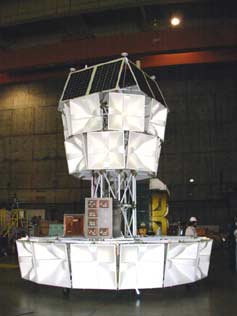
Handy Links
SLAC News Center
SLAC Today
- Subscribe
- Archives: Feb 2006-May 20, 2011
- Archives: May 23, 2011 and later
- Submit Feedback or Story Ideas
- About SLAC Today
SLAC News
Lab News
- Interactions
- Lightsources.org
- ILC NewsLine
- Int'l Science Grid This Week
- Fermilab Today
- Berkeley Lab News
- @brookhaven TODAY
- DOE Pulse
- CERN Courier
- DESY inForm
- US / LHC
SLAC Links
- Emergency
- Safety
- Policy Repository
- Site Entry Form

- Site Maps
- M & O Review
- Computing Status & Calendar
- SLAC Colloquium
- SLACspeak
- SLACspace
- SLAC Logo
- Café Menu
- Flea Market
- Web E-mail
- Marguerite Shuttle
- Discount Commuter Passes
-
Award Reporting Form
- SPIRES
- SciDoc
- Activity Groups
- Library
Stanford
Around the Bay
SLAC Creates Mini-Antarctica to Calibrate NASA Antenna
 During the first week of summer in the Northern Hemisphere, SLAC will be home to a mini-Antarctica.
During the first week of summer in the Northern Hemisphere, SLAC will be home to a mini-Antarctica.
Scientists are using a ten-ton block of ice in End Station A to calibrate the Antarctic Impulsive Transient Antenna (ANITA), a radio antenna array that will fly over the South Pole on a NASA balloon to search for ultra-high-energy cosmic neutrinos.
"These neutrinos are bound to exist, but no one has ever observed them," said Pisin Chen of the Kavli Institute for Particle Astrophysics and Cosmology (KIPAC), principal investigator for the test of ANITA. "Neutrinos don't like to interact, so we need an effective way to see them. We need a huge target, like the South Pole ice."
Neutrinos are produced when remnants from the early universe interact with ultra-high-energy cosmic rays. When neutrinos plunge into the polar ice, they create a shower of particles, which in turn generates radiation in many wavelengths—including radio waves, which ANITA is designed to detect—and visible light in the blue end of the spectrum.
ANITA arrived at SLAC on June 12. The one-week calibration tests began on Monday, June 19, when the linear accelerator first shot an electron beam into the ten-ton block of ice, triggering a particle shower that generated blue light in the ice with each pulse of the beam. Radio waves struck the detector as it dangled from a crane hook in End Station A's huge experimental hall.
"You want to calibrate this detector in situ to know exactly what signals you get when your incoming source (the beam) is well under control. This is the beauty of laboratory astrophysics," said Chen. He and KIPAC post-doctoral student Kevin Reil are members of the ANITA collaboration, which is a NASA project headed by Peter Gorham of the University of Hawaii.
"The SLAC accelerator is able to produce something as close as possible to nature's real signal," said Gorham. "Measurements made at SLAC will allow us to say with great confidence that our measurements at the South Pole are accurate."
The 20-foot tall by 15-foot diameter antenna array, which looks like white loud speakers for a concert mounted to a towering framework, will fly into the upper atmosphere on a balloon in December 2006, during the Antarctic summer. Over the course of the planned two-month flight, scientists hope ANITA will capture the first signs of ultra-high-energy neutrinos.
Neutrinos are the only particles with such extreme energies that they can make it through the atmosphere and penetrate the Earth. These particles are born when ultra-high-energy cosmic rays interact with photons that have pervaded space from the earliest days of the universe.
ANITA relies on the Askaryan effect, first proved at SLAC five years ago by Gorham and collaborators from SLAC and other institutions. The effect means that the shower of electrons and positrons triggered by a neutral neutrino starts with a net charge of zero but ends with an overall negative charge, because the positrons travel shorter distances before being attracted to electrons in the surrounding matter. In ice, this net charge induces something called Cherenkov radiation—which causes blue light and radio waves. Cherenkov radiation occurs when a charge moves faster than light can inside a material.
—Heather Rock Woods
SLAC Today, June 20, 2006
Image: The ANITA detector.